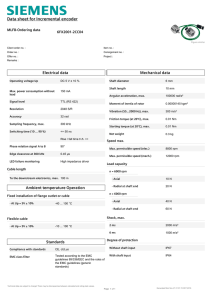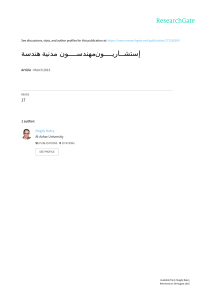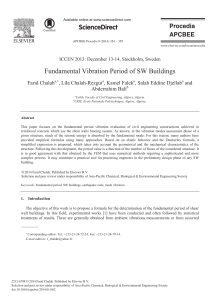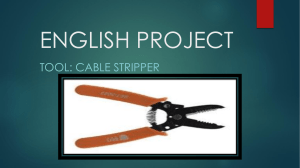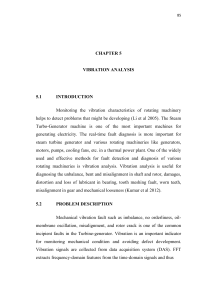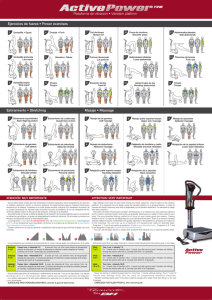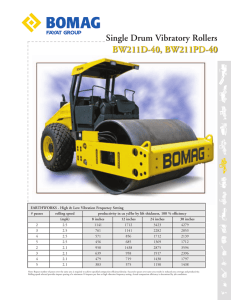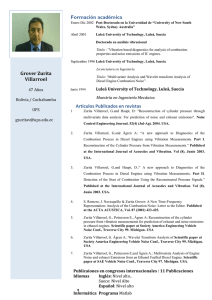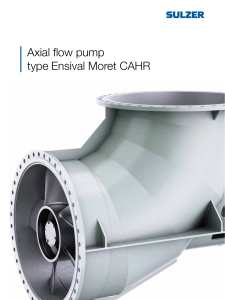Péton Field measurement tecchniques and instrumentation for torsional vibrations determination
Anuncio
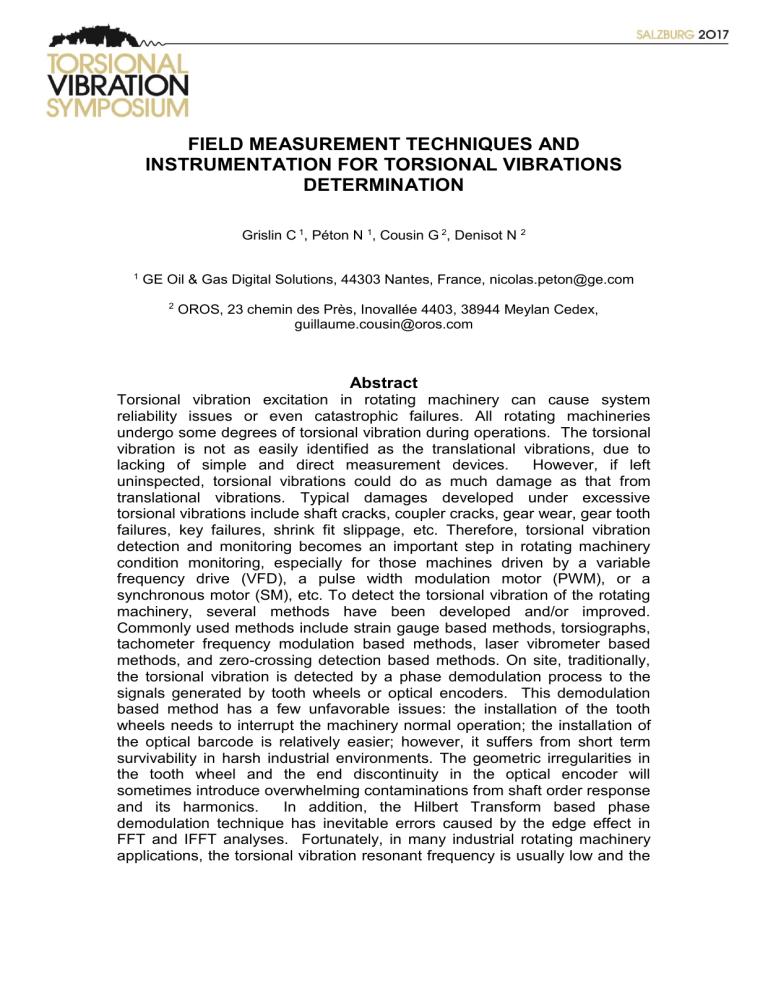
FIELD MEASUREMENT TECHNIQUES AND INSTRUMENTATION FOR TORSIONAL VIBRATIONS DETERMINATION Grislin C 1, Péton N 1, Cousin G 2, Denisot N 2 1 GE Oil & Gas Digital Solutions, 44303 Nantes, France, [email protected] 2 OROS, 23 chemin des Près, Inovallée 4403, 38944 Meylan Cedex, [email protected] Abstract Torsional vibration excitation in rotating machinery can cause system reliability issues or even catastrophic failures. All rotating machineries undergo some degrees of torsional vibration during operations. The torsional vibration is not as easily identified as the translational vibrations, due to lacking of simple and direct measurement devices. However, if left uninspected, torsional vibrations could do as much damage as that from translational vibrations. Typical damages developed under excessive torsional vibrations include shaft cracks, coupler cracks, gear wear, gear tooth failures, key failures, shrink fit slippage, etc. Therefore, torsional vibration detection and monitoring becomes an important step in rotating machinery condition monitoring, especially for those machines driven by a variable frequency drive (VFD), a pulse width modulation motor (PWM), or a synchronous motor (SM), etc. To detect the torsional vibration of the rotating machinery, several methods have been developed and/or improved. Commonly used methods include strain gauge based methods, torsiographs, tachometer frequency modulation based methods, laser vibrometer based methods, and zero-crossing detection based methods. On site, traditionally, the torsional vibration is detected by a phase demodulation process to the signals generated by tooth wheels or optical encoders. This demodulation based method has a few unfavorable issues: the installation of the tooth wheels needs to interrupt the machinery normal operation; the installation of the optical barcode is relatively easier; however, it suffers from short term survivability in harsh industrial environments. The geometric irregularities in the tooth wheel and the end discontinuity in the optical encoder will sometimes introduce overwhelming contaminations from shaft order response and its harmonics. In addition, the Hilbert Transform based phase demodulation technique has inevitable errors caused by the edge effect in FFT and IFFT analyses. Fortunately, in many industrial rotating machinery applications, the torsional vibration resonant frequency is usually low and the Torsional Vibration Symposium 2017, Salzburg, Austria keyphasor® and/or encoder for speed monitoring is readily available. Thus, it is feasible to use existing hardware for torsional vibration detection. INTRODUCTION Torsional vibrations in the rotating machinery are not easily perceived as the translational vibrations in stationary structures. However, the importance of the torsional vibrations is as high as that of the translational vibrations. The torsional vibrations usually cannot be directly sensed and transmitted for further data analysis. However, if left uninspected, torsional vibrations could do as much damage as that from translational vibrations. Typical damages developed under excessive torsional vibrations include shaft cracks, coupler cracks, gear wear, gear tooth failures, key failures, shrink fit slippage, etc. (IG-02-4, December, 2002, Wachel, 1993, Howes, October 28th / 29th, 2008). In addition, the coupling between the torsional and lateral vibrations may cause additional damage to the stationary structures as well [10]. Methods for detecting torsional vibrations of the rotating machinery have been limited. Historically, only a few methods have been successfully put into practical uses in industries. Typical industrial applications of those methods include strain gauge based methods [2, 1, 11], torsiographs [6, 7], tachometer frequency modulation based method [7, 11, 4], laser vibrometer based method [5, 13], and the time interval measurement (TIM) based method [15, 14, 3, 12]. Each method has its own pros and cons. For detailed analysis of each method, please refer to reference [8]. Torsional vibration detection using time interval measurement (TIM) is the most active approach and received a great deal of attention in recent years. There are numerous papers in the public domain on the research and application of the TIM method. The TIM approach utilizes the pulse train signal as in the phase/frequency demodulation method. Instead of using demodulation, the TIM based method calculates the time interval between the consecutive pulses first. The variation of the time intervals is then directly related to the shaft torsional vibration. Vance first described the TIM method in detail in the late 1980s [15]. Since then, there have been many different variations of algorithm development as well as successful applications. Several methods of TIM have been practically tried out on the field. The first one has been using a real-time OROS analyzer, using the toothed wheel signal. The second one uses the same equipment, but from an Optel Thevon optical probe with a zebra tape. Also, GE Bently Nevada developed a process for torsional vibration detection using the raw signal recorded from the Bently Nevada ADRE 408 DSPi and using a multi pulses per revolution. The last method uses once-per-revolution pulse train from the keyphasor® to identify 2, Field measurement techniques and instrumentation for torsional vibration determination, Paper No. 5B-4 Torsional Vibration Symposium 2017, Salzburg, Austria the torsional vibrations. All these methods have their positive and negative aspects so the goal is to understand which method is best to use in a case. However, the TIM based method is not without issues. Typically, it requires the pulse train generator and detector to be accurate in signal generating and detecting, otherwise, the shaft fundamental frequency component and its harmonics will overwhelm the torsional vibration signature. Although this geometry variation based effect can be alleviated by a synchronous averaging technique [(Resor, 2005)], the speed variation in the practical rotating machinery is still a problem since the traditional TIM based approach requires a constant speed operation to get the reference for determining the torsional vibration. Recently authors used a speed extract approach, which uses piecewise regression or wavelet filtering, which extended the TIM based torsional vibration extraction to aggressive speed variation cases, such as in speed-up or coast-down processes [8]. TIME INTERVAL MEASUREMENT APPLIED TO TURBOMACHINERY Steam Turbine generator test Three methods of TIM have been practically tried out on the field, using two different algorithms. All these methods have been experimented on a steam turbine generator unit installed on the GE Oil & Gas test bench facility in Florence, Italy for an acceptance test. Torsional vibration modes were previously calculated as in Figure 1, so comparison of the torsional natural frequency could be made with experimental results. When looking at the calculated modes there is a first one at 18.09 Hz (system mode) and then bucket modes (2nd and 3rd). The first mode is the first fundamental rigid torsional frequency of the train. The first mode would generally be the mode that is looked after, because it is a sub-synchronous frequency, so with a resonance during a transient event and because it has the maximum of energy. For the first mode, the nodal point is at the coupling. This mode is not expected to be influenced when the bucket flexibility is considered. This mode is expected to be most sensitive to the torsional stiffness changes at coupling. This mode is also characterized by just one nodal point along the axial length of the full train. By considering the TIM method, as opposed as the stress analysis method, the best location for the velocity measurement instrumentation would be at the anti-nodal point. Torsional Vibration Symposium 2017, Salzburg, Austria Figure 1: Theoretical torsional vibration modes identified with the model Three types of encoders were used on this test: First, existing toothed wheel at machine train’s end using permanently installed magnetic pickups. Timing wheel has 60 equally spaced teeth. Second, keyphasor® signal (one pulses per revolution) from proximity probe was recorded Third type of encoder is a temporary installed zebra tape (126 pulses per revolution) that was also installed on the rigid coupling, where shaft was free to access 4, Field measurement techniques and instrumentation for torsional vibration determination, Paper No. 5B-4 Torsional Vibration Symposium 2017, Salzburg, Austria Figure 2: Pictures showing timing wheel on bearing 1 of the machine on the left and zebra tapes of sensor #2 located at the coupling between the steam turbine and the generator on the right. Real time processing of the data First a 4-channels OROS analyzer (Figure 3, Left)) is used to perform a realtime measurement of the torsional vibration. The device has an integrated time interval encoder, high speed timer / counter with clock rates up to 6MHz that are used for encoding segment detection from the zebra tape or a toothed wheel. Both sensors were implemented to the steam turbine to compare results at three different locations Figure 3: 4-channel OROS analyzer, using over-sampled channels on the left and ADRE System from GE Bently Nevada on the right (front and back view). To measure the torsional natural frequency of the rotor during operation at steady state, excitation of the rotor is done by a sudden load change of the generator. Different load steps were performed but load rejection was the best excitation. The existing toothed wheel of the steam turbine had two spare magnetic sensors that could be used for the torsional test. The signal was directly Torsional Vibration Symposium 2017, Salzburg, Austria recorded by the analyzer. The most critical part of the measurement is the acquisition of the instantaneous speed, and especially the tooth pulse detection. The waveform signal of the toothed wheel is displayed on the top of the Figure 4. Below, the pulse signal converted by the analogue-to-digital counter is displayed. The last graph is the time-based signal of the torsional velocity. This graph represents the instantaneous velocity variation of the shaft, expressed in Deg/s Figure 4: Time base signal, counter and angular velocity of a toothed wheel signal and FFT spectrum of the instantaneous speed of the toothed wheel signal during the same period From this velocity oscillation around the average shaft speed, a Fourier Fast Transform can be performed by the real-time analyzer, in order to display the frequency spectrum of the torsional vibration. This spectrum shows two components: the torsional vibration frequency and a synchronous component (1X). The torsional vibration frequency identified on the spectrum can be compared to the one found by calculation of the theoretical model, Table 1. The comparison shows a perfect match between the model and the measurement, which brings confidence in the reliability of the system. Theoretical natural torsional frequency 18.04 Hz Measured natural torsional frequency 18.4 Hz Table 1: Comparison of natural torsional frequency between model and measurement This method allows us to identify the torsional mode in real-time. However, this method suffers of the insufficient teeth spacing precision. This geometric error introduces a synchronous component that should be considered as a noise. Unfortunately, it is not possible to cancel this component with this method. As a result, this could be a problem when both components perfectly match. The torsional natural frequency is clearly identified after resonance excitation, following the load rejection. A waterfall graphic displays multiple frequency spectrum of the torsional vibration in respect of time. 6, Field measurement techniques and instrumentation for torsional vibration determination, Paper No. 5B-4 Torsional Vibration Symposium 2017, Salzburg, Austria Postprocessing of the data The GE Bently Nevada machinery diagnostics team also developped its own Matlab based software in order to identify torsional vibration modes. This software post-processes the timebase signal of the pulse train in order to measure the time interval between two pulses. The timebase signal is recorded with an ADRE 408 DSPi (Figure 3 Right)using the raw mode capability, which digitized the signal at 128 KHz sampling rate and with 24 – bit A/D conversion. The signal is then exported to a tabular format to be read by the Matlab program. The shaft period/frequency is isolated, and the torsional vibration is extracted by comparing the identified average shaft speed and the instantaneous shaft speed.as displayed in Figure 5, in order to determine speed deviations and torsional vibrations. Figure 5: Instantaneous speed overlaid with the average speed of the shaft during a load rejection test on the steam turbine on the left. Torsional vibration of the teethed wheel during the load rejection time interval on the right This method can be validated by comparison with the method using the OROS equipment since both results give the same torsional frequency. However, due to the speed variation, and geometry error, the frequency spectrum is not representing the real torsional vibration spectrum. In order to get real torsional vibration only, a synchronous averaging is applied. The result of the transformation is displayed Figure 6, showing that only torsional frequency is left visible on the spectrum. Torsional Vibration Symposium 2017, Salzburg, Austria Figure 6: Torsional vibration spectrum after synchronous averaging of the teethed wheel during the load rejection time interval This solution is proven for torsional vibration identification and can be easiliy implemented on the field. Toothed wheel are often mounted on units, using induction sensors. These sensors are usually designed for overspeed detection or speed control and are critical for the machine operation. As a result, unless there is a spare sensor mounted on the toothed wheel, it is not recommended to connect a device in parallel of these sensors. In industrial rotating machinery, a Keyphasor® is usually preinstalled on the shaft for measurement of absolute phase and can be supplementary used for shaft speed detection. It is also the case that, in many rotor systems, the first torsional natural frequency is lower than the shaft speed. This opens the opportunity of using shaft once-per-revolution pulse train only to identify the torsional vibrations in rotating machinery systems. In this step, we allow the shaft speed to be a variable with respect to time, but the variation frequency is assumed to be lower than the lowest torsional modal frequency. This is a reasonable assumption for most of industrial applications. Therefore, the shaft period/speed variation has no frequency overlap with that from torsional vibrations. Under such assumptions, we may use low-pass filter to isolate the shaft period/frequency. However, in many cases, the low-pass filter cut-off frequency needs to be much lower than the sampling rate. A direct digital low-pass filter design may cause computation instability. In the tool, we used two approaches to isolate the shaft period/frequency: a wavelet decomposition based method and a piece-wise regression method. 8, Field measurement techniques and instrumentation for torsional vibration determination, Paper No. 5B-4 Torsional Vibration Symposium 2017, Salzburg, Austria Once the shaft period/frequency is isolated, the torsional vibration is extracted by comparing the identified shaft speed and the instantaneous shaft speed. Since there is no pulse geometric variation error in a once-per-revolution sensor, such as the tooth gear spacing error and optical barcode end joint error, it is expected to have less shaft order related noise contamination in the identified torsional vibrations. The torsional vibration is converted in terms of shaft angles, just like it was done with multiple pulses per revolution signal. Many techniques have been tried out to effectively measure the instantaneous angular velocity. Temporary solutions must be also used in some cases where toothed wheel and keyphasor® cannot be used. An optical encoder can be mounted on the shaft, away from the nodal point. This optical encoder can be an optical probe pointing to a zebra tape with reflecting stripes. The transducer output is a high or low voltage (0 to 5V) depending on whether it detects “white” or “black” region of the transducer segments. If the machine train is not instrumented with a keyphasor®, it is possible to mark the zebra tape with a missing tooth by blacking out up to 3 pulses. Timebase signal collected from the zebra tape, Figure 7, shows the signal does not always have the same amplitude and is not as clean as the toothed wheel signal. Figure 7: Time base signal of a zebra tape, showing the imperfections of the tape Torsional Vibration Symposium 2017, Salzburg, Austria Instrumentation related issues Instrumentation is probably the most sensitive part of the measurement. The Zebra Encoder tape allows for torsional vibration measurements to be taken on the machine in question. To do this the tape needs to be fitted and then observed with either an optical or laser tachometer. Among the most often problems met on site, are: The probe bracket should be stiff enough to be always parallel to the shaft. One possible cause of the signal amplitude variation is the vibration of the probe itself due to lack of enough stiffness of the bracket. As the zebra tape is self-adhesive (sticky backed) then the area of the shaft in question must be clean prior to any application to guarantee a good hold. Therefore, any surface corrosion, dirt, grease or any other contaminates must be removed from the entire circumference of the shaft area intended for mounting. This is commonly done with a wire brush, emery paper and alcohol free wipes. Although the tools may differ depending on machine location and size, the aim of providing a clean mounting surface remains the same. Once the shaft surface is clean, mounting of the zebra tape can proceed. It is important to try and keep the tape as close to perpendicular as possible. This does not have to be excessively precise but checking the distance from a datum (like a bearing housing, shaft collar, etc.) to confirm the tape is being fitted the same distance at regular points along the shaft is one way of confirming this. In some cases, it may be preferable to use a Tailor’s tape to create a checked datum line first to fit the zebra tape against, as shown below. This temporary tape is removed once the zebra tape is in place. The tape will need to be cut so that it correctly fits the shaft circumference (Figure 8). To determine where to cut the tape place the tape around the shaft and mark were the two ends will meet on the long end of the tape. The preference is for the tape to meet exactly without the two ends overlapping or falling short. However, it is preferable to fall slightly short if need be as an overlap can cause spurious signals. At this point cut the tape and make a note of how many stripes are present on the cut length. This number is needed later for signal processing. 10, Field measurement techniques and instrumentation for torsional vibration determination, Paper No. 5B-4 Torsional Vibration Symposium 2017, Salzburg, Austria Figure 8: Alignment and length Junction of the tape can be an issue too as it can be seen on Figure 9, since overlaping the tape can introduce a gap error. Ideally, the best way to make the junction is to tape edge-to-edge. However, this is not practically possible since there is always a thin gap between both ends of the tape. The shaft beeing reflective, this could add a false pulse into the signal. That’s the reason why a missing tooth can be introduce at that area, as seen on Figure 10. Missing teeth are generally created with black paint and can include one to three pulses, as seen Figure 9. To mount the zebra tape all that is needed is to remove the protective packaging and place the tape adhesive side down onto the shaft using the datum as a reference to make sure the tape is fitted perpendicular. Run a clean hand over the tape slowly as you fit it to make sure no air bubbles or creases form during fitting. However, once the tape ends are next to one another it is common to have a single abnormal length stripe. This should be, or made to be, one extra-long black stripe. To do this use a marker pen followed by a length of black electrical tape to color then secure the tape ends, as illustrated in Figure 10 (top left). If the tape will be left fitted for extended periods or exposed to adverse conditions (weather, temperature) it is recommended to use additional adhesive tape on both side of the zebra tape to secure it. When doing this, it is preferable to trap the tape used previously to secure the ends of the zebra tape under it, as on Figure 10(bottom left). When fitting the additional adhesive tape, it is preferable to mount it on an equally clean surface and to take note of the shaft direction of rotation when deciding which end to put under the other, Figure 10 (bottom right). This should be considered as having the joint facing away from the direction of travel reduces windage effects on the joint and therefore reduces the likelihood of any problem being made worse by windage. Torsional Vibration Symposium 2017, Salzburg, Austria 3 missing teeth Figure 9: Missing teeth counting showing error due to tape overlap Figure 10: Missing teeth black painted on the zebra tap. Once the tape ends are next to one another it is common to have a single abnormal length stripe. This should be, or made to be, one extra-long black stripe. To do this use a marker pen followed by a length of black electrical tape to colour then secure the tape ends, as illustrated on the right. When using a laser, it should be no closer than 15cm from the shaft and at an angle (Figure 11). Not directly perpendicular to the shaft, as below. The laser tacho will work best if the tape is well lit however care must be taken to use a consistent light source such as a light or LED. Not a light force that can flicker, such as a florescent light. This must be avoided as a flickering or changing light will cause amplitude modulation which in turn can cause problems when post processing the data 12, Field measurement techniques and instrumentation for torsional vibration determination, Paper No. 5B-4 Torsional Vibration Symposium 2017, Salzburg, Austria Figure 11: Mounting the laser. Comparison of each TIM methods: positive and negative aspects Toothed wheel Keyphasor® Zebra tape Positive Already mounted on the machine train Clean signal Already mounted on the rotor Can be mounted on other location with laser keyphasor® Can be implemented on multiple location Negative Need to measure from a spare sensor No choice of location Typical applications Large machinery acceptance test during Limited in frequency resolution and span Any machinery for torsional natural frequency identification below half rotating speed Signal quality issue Machine must be shut down for mounting the instrumentation Machinery without toothed wheel access and with torsional natural frequency higher than half the rotating speed. Also, can be used for stress analysis of a coupling Table 2: comparison of each TIM methods CONCLUSION TIM method is a powerful way to identify torsional natural frequency. Several methods of analysis and instrumentation exist and choosing the right one is critical. Most of the cases applied to turbomachinery where the 1st torsional mode is below half of the operating speed frequency, the keyphasor® offers then an interesting choice. This method offers good results for torsional vibration identification but instrumentation is difficult to set up. However, it offers good resolution and flexibility for the location plane. Also, it is mandatory to implement a signal processing algorithm like a synchronous averaging on the measurement to effectively remove the irregularities caused by the timing wheel or barcode spacing. Torsional Vibration Symposium 2017, Salzburg, Austria This opens another field of torsional vibration measurement which focuses on the stress caused by the shaft torque. Indeed, by measuring the instantaneous velocity on both sides of the coupling, it is possible to measure the twist angle after a torque is applied on the driven machine (like a load rejection). A stress analysis generated on the nodal point of the rotor (typically the coupling) could also be done. It can be done with the TIM method using two TIM planes on both sides of the nodal point. It would require then the use of two multiple pulses-per-revolution signal as a zebra tape. REFERENCES [1] [2] [3] [4] [5] [6] [7] [8] [9] [10] [11] [12] [13] [14] [15] Eshleman, R. (1977). Torsional Vibration of Machine Systems. Proceedings of the 6th Turbomachinery Symposium (pp. 13-22). Houston, TX: Texas A&M University Feese, T. a. (September, 2008). Torsional Vibration Problem with Motor/ID Fan System Due to PWM Variable Frequency Drive. 37th Turbomachinery Symposium. Houston, TX Golebiowski, M. N. (2010). Train Torsional Vibrations: Monitoring System Based on Model Result. Proceedings of ASME Turbo Expo, (pp. GT2010-22908). Glasgow, UK Groover, C. L. (2005). Removal of order domain content in rotating equipment signals by double resampling. Mechanical Systems and Signal Processing, 19(3), 483-500 Hallwell, N. P. (1984). The laser torsional vibrometer: a new instrument. Journal of Sound and Vibration, 93(4), 588-592 Howes, B. a. (October 28th / 29th, 2008). Torsional Vibration Case Study Highlights Design Considerations. 6th Conference of the EFRC. Dusseldorf Leader, M. a. (2004). Practical Implementation of Torsional Analysis and Field Measurement. National Technical Training Symposium of the Vibration Institute Luo, H. C. (2013). Torsional Vibration Detection Using High Sampling Rate and High Resolution Keyphasor® Information. Proceedings of the ASME 2013 International Design Engineering Technical Conferences & Computers and Information in Engineering Conference. Portland, OR Maynard, K. P. (2001). Blade and Shaft Crack Detection Using Torsional Vibration Measurements Part 3: Field Application Demonstrations. Noise and Vibration Worldwide(Vol. 32), 16-23 Muszynska, A. G. (1992). Torsional/Lateral Cross-Coupled Responses Due to Shaft Anisotropy: A New Tool in Shaft Crack Detection. C432-090, Bath, United Kingdom: I. Mech. E Naldi, L. B. (June 9–13, 2008). Torsional Vibration, in Rotordynamic System, Identified by Monitoring Gearbox Behavior. ASME Turbo Expo, (pp. 1247-1256). Berlin, Germany Naldi, L. G. (2011). New approach to torsional vibration monitoring. Proceedings of the Fortieth Turbomachinery Symposium. Houston, TX Oberholster, A. J. (2012). The Removal of Speckle Noise from Torsional Laser Doppler Vibrometer Signals in Machine Health Monitoring. 18th World Conference on Nondestructive Testing, (pp. 16-20). Durban, South Africa Rossi, V. N. (2009). Torsional Vibration in Rotordynamic Systems: Smart Investigation Methods. Proceedings of ASME Turbo Expo , (pp. GT2009-59608). Orlando, FL Vance, J. (1988). Rotordynamics of Turbomachinery. Wiley, New York 14, Field measurement techniques and instrumentation for torsional vibration determination, Paper No. 5B-4
